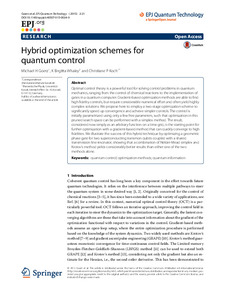| dc.date.accessioned | 2016-01-19T07:51:54Z | |
| dc.date.available | 2016-01-19T07:51:54Z | |
| dc.date.issued | 2015 | |
| dc.identifier.issn | 2196-0763 | |
| dc.identifier.uri | urn:nbn:de:hebis:34-2016011949686 | |
| dc.identifier.uri | http://hdl.handle.net/123456789/2016011949686 | |
| dc.description.sponsorship | Gefördert durch den Publikationsfonds der Universität Kassel | |
| dc.language.iso | eng | |
| dc.publisher | Springer Open | |
| dc.rights | Urheberrechtlich geschützt | |
| dc.rights.uri | https://rightsstatements.org/page/InC/1.0/ | |
| dc.subject.ddc | 530 | |
| dc.title | Hybrid optimization schemes for quantum control | eng |
| dc.type | Aufsatz | |
| dcterms.abstract | Optimal control theory is a powerful tool for solving control problems in quantum mechanics, ranging from the control of chemical reactions to the implementation of gates in a quantum computer. Gradient-based optimization methods are able to find high fidelity controls, but require considerable numerical effort and often yield highly complex solutions. We propose here to employ a two-stage optimization scheme to significantly speed up convergence and achieve simpler controls. The control is initially parametrized using only a few free parameters, such that optimization in this pruned search space can be performed with a simplex method. The result, considered now simply as an arbitrary function on a time grid, is the starting point for further optimization with a gradient-based method that can quickly converge to high fidelities. We illustrate the success of this hybrid technique by optimizing a geometric phase gate for two superconducting transmon qubits coupled with a shared transmission line resonator, showing that a combination of Nelder-Mead simplex and Krotov’s method yields considerably better results than either one of the two methods alone. | eng |
| dcterms.accessRights | open access | |
| dcterms.bibliographicCitation | In: EPJ quantum technology. - Berlin ; Heidelberg [u.a.] : Springer Open, 2015, 2, 21, 1-16 | |
| dcterms.creator | Goerz, Michael H. | |
| dcterms.creator | Whaley, K. Birgitta | |
| dcterms.creator | Koch, Christiane P. | |
| dc.publisher.place | Berlin; Heidelberg [u.a.] | |
| dc.relation.doi | doi:10.1140/epjqt/s40507-015-0034-0 | |
| dcterms.source.issue | 21 | |
| dcterms.source.journal | EPJ quantum technology | |
| dcterms.source.pageinfo | S. 1-16 | |
| dcterms.source.volume | 2 | |

